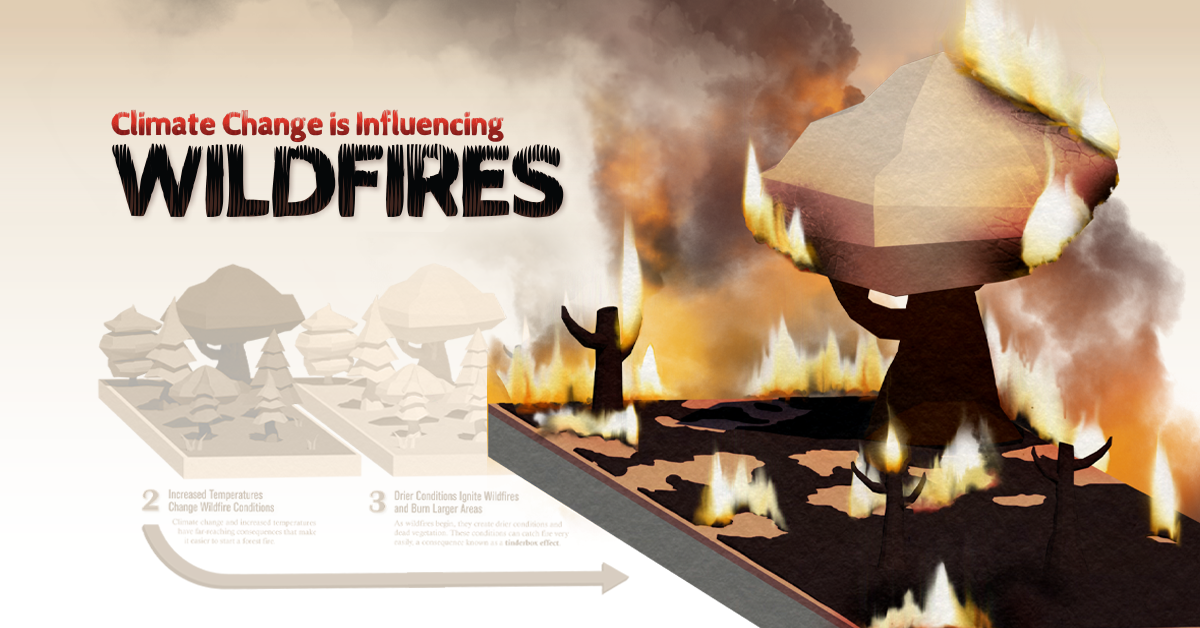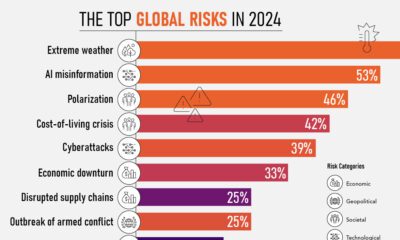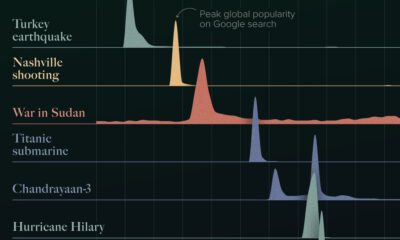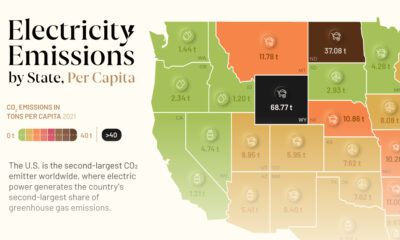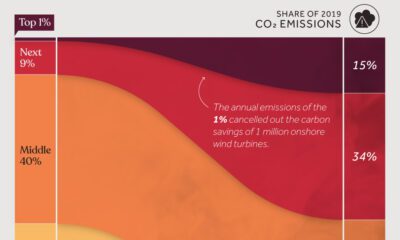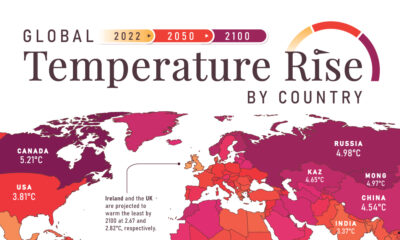Green
Explained: The Relationship Between Climate Change and Wildfires
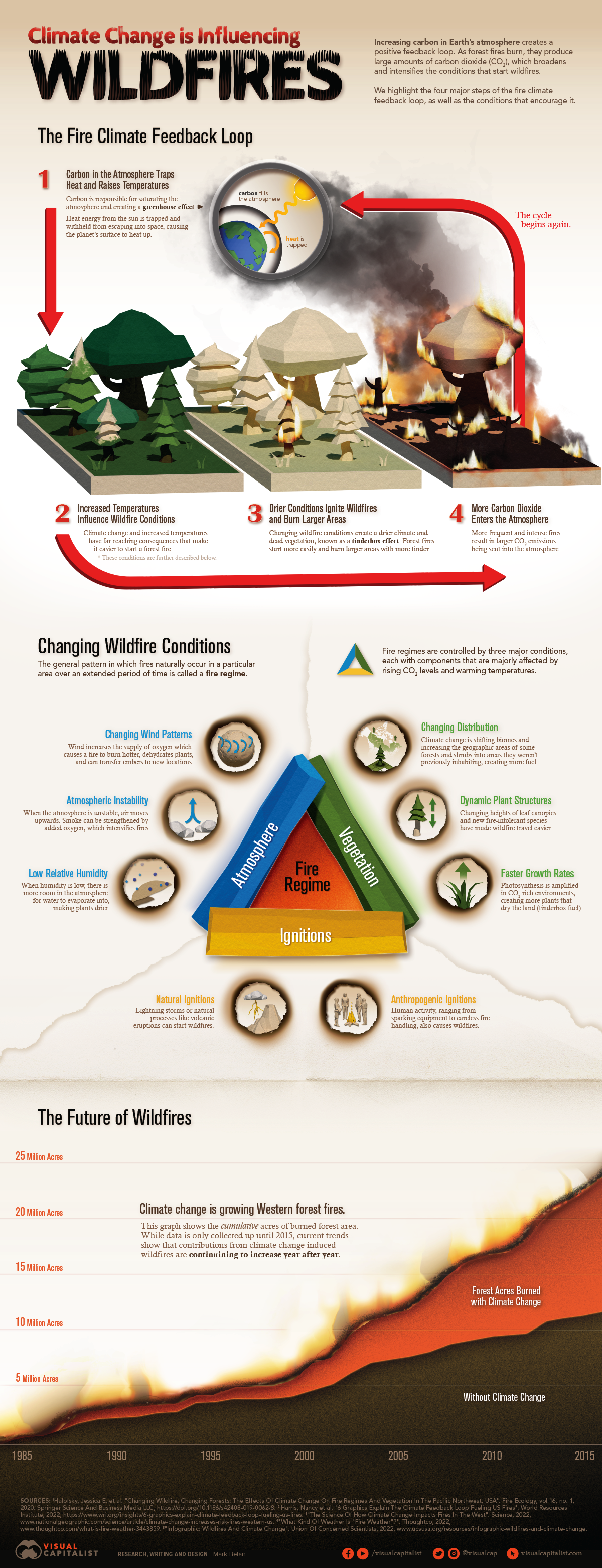
How Climate Change is Influencing Wildfires
Each year, thousands of wildfires burn through millions of acres of land around the world.
We’ve already seen the mass devastation that wildfires can bring, especially in places like Australia, Serbia, and California. But new research by the UN indicates that things might get even worse by the end of the century. By 2100, the frequency of wildfires could increase by up to 50%.
What’s causing this influx of wildfires around the world? Below, we dig into how climate change is impacting wildfires—and how in turn, wildfires are impacting climate change.
Climate Conditions That Support Wildfires
Before diving in, it’s worth going over the basics of wildfires, and how they get started in the first place. An area’s vulnerability to wildfires, also known as its fire regime, depends on three major conditions: its atmosphere, vegetation, and ignitions.
① Atmosphere
Atmosphere plays a big part in how sensitive an area is to wildfires. For instance, wind can increase oxygen supply in an area, which would help fuel a wildfire, and may even transfer embers to new locations.
② Vegetation
Vegetation is also a huge factor in whether or not an area is vulnerable to wildfires. A region with drier vegetation may catch fire more easily, and an area with more forest or shrubs provides more fuel for potential blazes.
③ Ignitions
An area that’s close to volcanic activity, or prone to lightning storms may be more susceptible to wildfires. However, human activity like campfires or faulty equipment can also trigger fires, so popular areas for camping or logging may be at higher risk as well.
While these conditions vary depending on the location, in general, fire regimes are being impacted by climate change, which is causing an influx in the duration and intensity of wildfires around the world.
The Fire Climate Feedback Loop
Since the 1850s, global surface temperatures have risen by about 1.0°C (1.8°F).
These increased surface temperatures have had far-reaching impacts on our climate—in the Northern Hemisphere, warmer temperatures have led to less snow, earlier arrival of spring, and ultimately longer, drier fire seasons.
These longer fire seasons have led to an influx of wildfires. But here’s the kicker—wildfires emit tons of carbon. In 2021, wildfires around the world emitted an estimated 1.76 billion tonnes of carbon into the atmosphere, which for context, is more than double the annual emissions from the entire country of Germany.
This carbon gets trapped in our atmosphere and contributes to rising surface temperatures. In other words, more carbon creates more wildfires—and more wildfires create more carbon.
Extreme Weather Events Are Rising In General
It’s not just wildfires that are growing in frequency and intensity because of climate change—droughts, heatwaves, and floods are also becoming more common around the world.
This year, temperatures reached all-time highs across Europe, which wrecked havoc across the continent, impacted infrastructure, and even took lives.
Experts warn that this may become the new normal. To help mitigate risk, governments, policymakers, and companies need to band together to create safeguards and establish proper preventative measures.
Green
How Carbon Credits Can Help Close the Climate Funding Gap
To keep a 1.5℃ world within reach, global emissions need to fall by as much as 45% by 2030, and carbon credits could help close the gap.
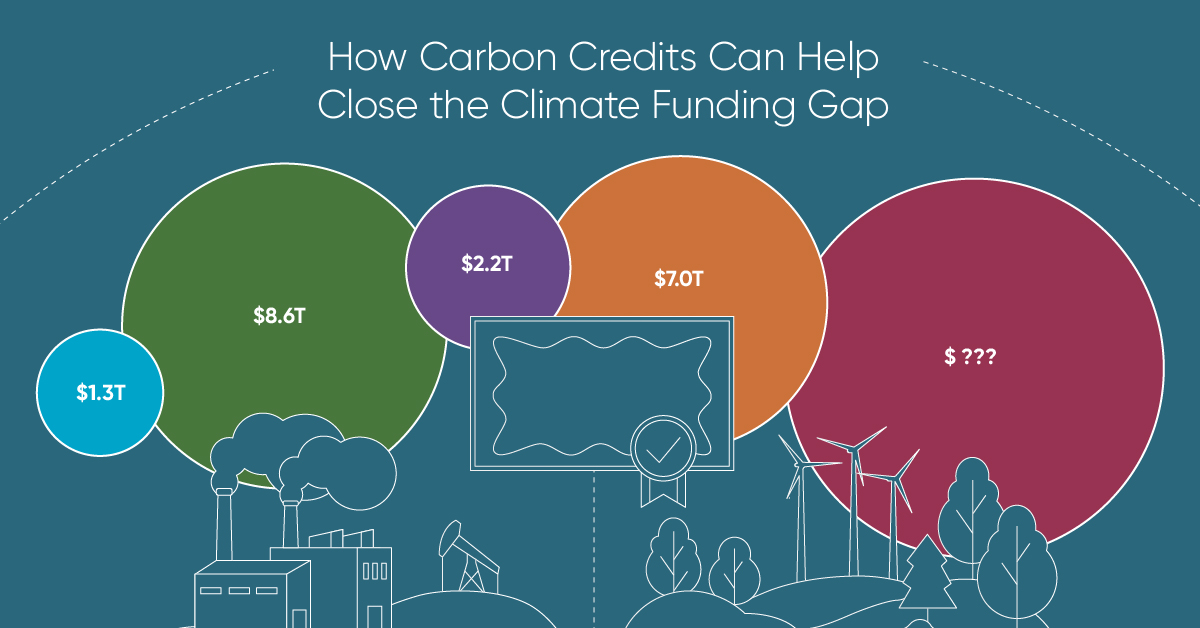
How Carbon Credits Can Help Close the Climate Funding Gap
Governments around the world have committed to the goals of the Paris Agreement, but their climate pledges are insufficient. To keep a 1.5℃ world within reach, global emissions need to fall by as much as 45% by 2030.
Bold and immediate action is essential, but so are resources that will make it happen.
In this graphic, we have partnered with Carbon Streaming to look at the role that the voluntary carbon market and carbon credits can play in closing that gap.
More Funds are Needed for Climate Finance
According to data from the Climate Policy Initiative, climate finance, which includes funds for both adaptation and mitigation, needs to increase at least five-fold, from $1.3T in 2021/2022, to an average $8.6T annually until 2030, and then to just over $10T in the two decades leading up to 2050.
That adds up to a very large number, but consider that in 2022, $7.0T went to fossil fuel subsidies, which almost covers the annual estimated outlay. And the world has shown that when pressed, governments can come up with the money, if the global pandemic is any indication.
Mobilizing Carbon Finance to the Developing World
But the same cannot be said of the developing world, where debt, inequality, and poverty reduce the ability of governments to act. And this is where carbon credits can play an important role. According to analyses from Ecosystem Marketplace, carbon credits help move capital from developed countries, to where funds are needed in the developing world.
For example, in 2019, 69.2% of the carbon credits by volume in the voluntary carbon market were purchased by buyers in Europe, and nearly a third from North America. Compare that to over 90% of the volume of carbon credits sold in the voluntary carbon market in 2022 came from projects that were located outside of those two regions.
Carbon Credits Can Complement Decarbonization Efforts
Carbon credits can also complement decarbonization efforts in the corporate world, where more and more companies have been signing up to reduce emissions. According to the 2022 monitoring report from the Science Based Targets initiative, 4,230 companies around the world had approved targets and commitments, which represented an 88% increase from the prior year. However, as of year end 2022, combined scope 1 and 2 emissions covered by science-based targets totaled approximately 2 GtCO2e, which represents just a fraction of global emissions.
The fine print is that this is just scope 1 and 2 emissions, and doesn’t include scope 3 emissions, which can account for more than 70% of a company’s total emissions. And as these emissions come under greater and greater scrutiny the closer we get to 2030 and beyond, the voluntary carbon credit market could expand exponentially to help meet the need to compensate for these emissions.
Potential Carbon Credit Market Size in 2030
OK, but how big? In 2022, the voluntary carbon credit market was around $2B, but some analysts predict that it could grow to between $5–250 billion by 2030.
| Firm | Low Estimate | High Estimate |
|---|---|---|
| Bain & Company | $15B | $30B |
| Barclays | N/A | $250B |
| Citigroup | $5B | $50B |
| McKinsey & Company | $5B | $50B |
| Morgan Stanley | N/A | $100B |
| Shell / Boston Consulting Group | $10B | $40B |
Morgan Stanley and Barclays were the most bullish on the size of the voluntary carbon credit market in 2030, but the latter firm was even more optimistic about 2050, and predicted that the voluntary carbon credit market could grow to a colossal $1.5 trillion.
Carbon Streaming is Focused on Carbon Credit Integrity
Ultimately, carbon credits could have an important role to play in marshaling the resources needed to keep the world on track to net zero by 2050, and avoiding the worst consequences of a warming world.
Carbon Streaming uses streaming transactions, a proven and flexible funding model, to scale high-integrity carbon credit projects to advance global climate action and UN Sustainable Development Goals.

Learn more at www.carbonstreaming.com.

-

 Green1 week ago
Green1 week agoRanking the Top 15 Countries by Carbon Tax Revenue
This graphic highlights France and Canada as the global leaders when it comes to generating carbon tax revenue.
-

 Green1 week ago
Green1 week agoRanked: The Countries With the Most Air Pollution in 2023
South Asian nations are the global hotspot for pollution. In this graphic, we rank the world’s most polluted countries according to IQAir.
-

 Environment2 weeks ago
Environment2 weeks agoTop Countries By Forest Growth Since 2001
One country is taking reforestation very seriously, registering more than 400,000 square km of forest growth in two decades.
-

 Green3 weeks ago
Green3 weeks agoRanked: Top Countries by Total Forest Loss Since 2001
The country with the most forest loss since 2001 lost as much forest cover as the next four countries combined.
-

 Markets2 months ago
Markets2 months agoThe World’s Top Cocoa Producing Countries
Here are the largest cocoa producing countries globally—from Côte d’Ivoire to Brazil—as cocoa prices hit record highs.
-
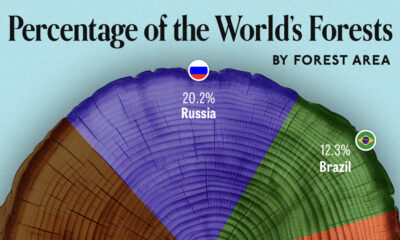
 Environment2 months ago
Environment2 months agoCharted: Share of World Forests by Country
We visualize which countries have the biggest share of world forests by area—and while country size plays a factor, so too, does the environment.
-

 Markets1 week ago
Markets1 week agoU.S. Debt Interest Payments Reach $1 Trillion
-

 Markets2 weeks ago
Markets2 weeks agoRanked: The Most Valuable Housing Markets in America
-

 Money2 weeks ago
Money2 weeks agoWhich States Have the Highest Minimum Wage in America?
-

 AI2 weeks ago
AI2 weeks agoRanked: Semiconductor Companies by Industry Revenue Share
-

 Markets2 weeks ago
Markets2 weeks agoRanked: The World’s Top Flight Routes, by Revenue
-

 Countries2 weeks ago
Countries2 weeks agoPopulation Projections: The World’s 6 Largest Countries in 2075
-

 Markets2 weeks ago
Markets2 weeks agoThe Top 10 States by Real GDP Growth in 2023
-

 Money2 weeks ago
Money2 weeks agoThe Smallest Gender Wage Gaps in OECD Countries




